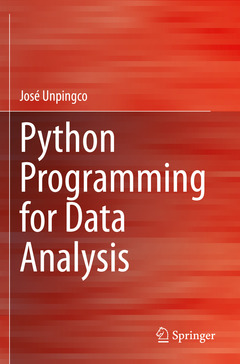Description
Python Programming for Data Analysis, 1st ed. 2021
Language: English
Subjects for Python Programming for Data Analysis:
Publication date: 05-2022
263 p. · 15.5x23.5 cm · Paperback
Publication date: 05-2021
263 p. · 15.5x23.5 cm · Hardback
Description
/li>Contents
/li>Biography
/li>Comment
/li>
After developing the key Python language features, the book moves on to third-party modules that are foundational for effective data analysis, starting with Numpy. The book develops key Numpy concepts and discusses internal Numpy array data structures and memory usage. Then, the author moves onto Pandas and details its many features for data processing and alignment. Because strong visualizations are important for communicating data analysis, key modules such as Matplotlib are developed in detail, along with web-based options such as Bokeh, Holoviews, Altair, and Plotly.
The text is sprinkled with many tricks-of-the-trade that help avoid common pitfalls. The author explains the internal logic embodied in the Python language so that readers can get into the Python mindset and make better design choices in their codes, which is especially helpful for newcomers to both Python and data analysis.To get the most out of this book, open a Python interpreter and type along with the many code samples.
Introduction.- Basic Language.- Basic Data Structures.- Basic Programming.- File Input/Output.- Dealing with Errors.- Power Python Features to Master.- Advanced Language Features.- Using modules.- Object oriented programming.- Debugging from Python.- Using Numpy – Numerical Arrays in Python.- Data Visualization Using Python.- Bokeh for Web-based Visualization.- Getting Started with Pandas.- Some Useful Python-Fu.- Conclusion.
Dr. José Unpingco completed his PhD from the University of California, San Diego (UCSD) in 1997 and has since worked in industry as an engineer, consultant, and instructor on a wide variety of advanced data science topics, with deep experience in machine learning. He was the onsite technical director for large-scale Signal and Image Processing for the Department of Defense (DoD) where he also spearheaded the DoD-wide adoption of scientific Python. Dr. Unpingco is currently the Senior Director for Data Science for the Gary and Mary West Health Institute, a non-profit Medical Research Organization in San Diego, California. He is also a Data Science lecturer at UCSD for undergraduate and graduate degree programs and the author of Python for Signal Processing, and Python for Probability, Statistics, and Machine Learning.




